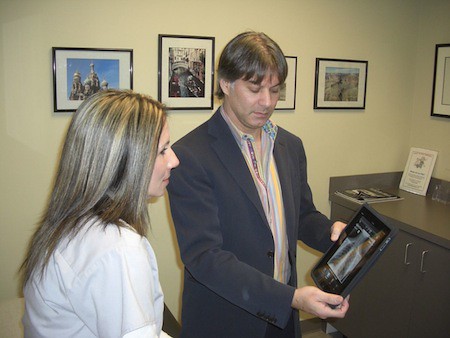
Image via Non-Surgical Orthopaedics, P.C.
By J. Vegerano
I was at my doctors office recently and noticed that he now uses IBM touch screen tablets in several areas of his practice. I spoke to my doctor in a bit of detail about why he chose to implement these tablets, and his answer was simple: technology is at the forefront of healthcare and it makes his practice run seamlessly. He can now e-mail a prescription or view medical records and documentation without paper clutter or waste (which I considered to be a “green move). All data is now collected – quite legibly, I might add – with a few clicks, and requests for lab or any other results streamed over their wireless network. Communication between front desk, medical assistants, and doctors was also in real-time. They were able to maintain constant communication while attending to other patients and/or duties in various locations throughout the office.
Here on Pixels & Pills, we talk a lot about what technology could do for the healthcare space. Just this time last year, we were caught up in the excitement of the iPad and its potential to change medicine forever. It’s exciting, especially for someone like me, to see tablets transform from an innovation into an everyday part of our lives. This kind of adoption of technology in the doctor’s office is taking place all across the country, across different disciplines. Just a few days ago, pediatrician Natasha Burgert, MD wrote a blog post about the different ways she uses her iPad at the point of care.
As a technology professional, I have learned that in this business, being proactive with technology is key to any successful implementation or upgrade. What I mean is: it’s not as simple as going out and buying a few iPads for your office, participating in basic level training, and off you go. You need to make important, often complex decisions about your systems and software, and pay close attention to tech maintenance.
That being said, I strongly support the data cloud movement and tech integration, but I also believe in a strong backup strategy. When it comes to sensitive data like electronic medical records, there must be wireless security, encryption, and off-site secure data backup. Also, it’s important to maintain a working relationship with an available technology consultant for full or partial tech support as needed. That consultant should also have remote access for troubleshooting and remote assistance. A backup tablet pre-installed with all essential business apps wouldnt be a bad idea, either.
Implementing tablet technology – or any kind of technology, really – is a great move and will benefit the staff, office productivity, and ultimately patient satisfaction. Even though I know I’m preaching to the choir, as we continue to design solutions for tablet utilization at the point of care, we sometimes forget that it’s instrumental and critical to the success of any tech integration to include a solid redundancy backbone strategy for “just those kinds of emergencies.